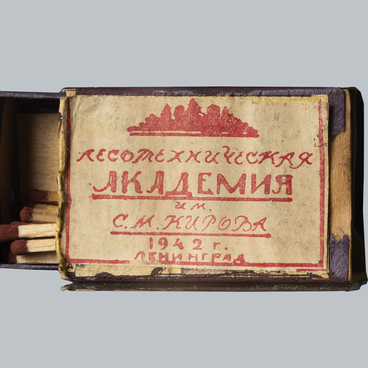The Military Medical Museum houses a paper label with a red cross emblem. The red cross is used as a protection marking in armed conflicts to mark the medical services of armed forces and humanitarian organizations which are guaranteed protection under international law because they alleviate the suffering of the wounded, prisoners, and civilians.
Under the Geneva Convention, it is prohibited to use the official symbols of the International Red Cross Movement to conceal crimes against humanity. However, the Nazis attached such labels to the boxes they sent from the Sachsenhausen concentration camp under the guise of medical supplies, while in fact, the boxes contained the belongings of people who had been executed in the camp.
The Sachsenhausen camp was established in 1936. It became a kind of training center for Schutzstaffel (SS) officers. Guards for dozens of other concentration camps across Europe were trained there, while the SS also practiced various types of torture, and developed a system for preventing camp prisoners from escaping.
Mass murders began at Sachsenhausen in the fall of 1941, and a year and a half later, the first gas chambers were constructed next to the camp crematorium. Upon entering the camp, newcomers were quickly screened, and those unfit for labor were executed.
Under the pretext of tuberculosis vaccination, prisoners were injected with lethal phenol injections. When the poisonous gas was unavailable, the Nazis replaced it with air. Prisoners were also drowned in ice-cold showers. Shootings and hangings became widespread. The exact number of victims cannot be estimated, as those unfit for work were immediately sent to death, without being registered in the camp record books.
This is a label from a metal container of Cyclone B — a cyanide-based pesticide. As a result of a series of experiments in mass gassing, this product was chosen by the Nazis as the preferred killing tool. The label was brought from the camp by Faust Shkaravsky, lieutenant colonel of the Medical Corps and the chief forensic medical expert of the First Belorussian Front.
Under the Geneva Convention, it is prohibited to use the official symbols of the International Red Cross Movement to conceal crimes against humanity. However, the Nazis attached such labels to the boxes they sent from the Sachsenhausen concentration camp under the guise of medical supplies, while in fact, the boxes contained the belongings of people who had been executed in the camp.
The Sachsenhausen camp was established in 1936. It became a kind of training center for Schutzstaffel (SS) officers. Guards for dozens of other concentration camps across Europe were trained there, while the SS also practiced various types of torture, and developed a system for preventing camp prisoners from escaping.
Mass murders began at Sachsenhausen in the fall of 1941, and a year and a half later, the first gas chambers were constructed next to the camp crematorium. Upon entering the camp, newcomers were quickly screened, and those unfit for labor were executed.
Under the pretext of tuberculosis vaccination, prisoners were injected with lethal phenol injections. When the poisonous gas was unavailable, the Nazis replaced it with air. Prisoners were also drowned in ice-cold showers. Shootings and hangings became widespread. The exact number of victims cannot be estimated, as those unfit for work were immediately sent to death, without being registered in the camp record books.
This is a label from a metal container of Cyclone B — a cyanide-based pesticide. As a result of a series of experiments in mass gassing, this product was chosen by the Nazis as the preferred killing tool. The label was brought from the camp by Faust Shkaravsky, lieutenant colonel of the Medical Corps and the chief forensic medical expert of the First Belorussian Front.


